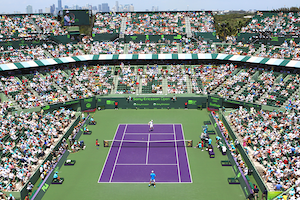 For as long as I live, when I think of the red clay at Roland Garros, the picture that will always come to mind is that of Brazilian Gustavo Kuerten tracing the contours of a heart on the ground after his grueling five sets win over Swede Magnus Norman in the 2000 French Open final.
For as long as I live, when I think of the red clay at Roland Garros, the picture that will always come to mind is that of Brazilian Gustavo Kuerten tracing the contours of a heart on the ground after his grueling five sets win over Swede Magnus Norman in the 2000 French Open final.
Bar none, clay is the most demanding surface to play on. The points can be endless. A men’s three set match can last longer than three hours. Thus, that type of court can exact a significant mental and physical price. Ironically though, clay is much gentler on the body than a hard court where joints can be prone to injury. Despite the clay presenting some significant health benefits, the list of players who excel on that specific turf is far shorter than that of those who perform well on hard court. Therefore, the question must be posed as to the source of this disconnection.
One explanation may be the competitors’ lack of familiarity with the surface. The majority of Americans and non- Iberian Europeans nowadays grow up playing on concrete. Red clay practice courts and tournaments have become a rarity in the U.S. Currently, the ladies have a choice of either Charleston or Jacksonville; many have characterized both as “simulated clay”. Players have described the green surface as a hard court dusted with clay which makes their movement feel awkward. For the men, their only option is the U.S. Clay Court Championships in Houston. Although it is more suitable than what’s available to the women, in many respects it falls short of the necessary requisite to offer a full fledge European red clay experience.
Why is this important? The players who have traditionally done well at red clay court tournaments have had a steady diet of it since childhood. Floridian Chris Evert was raised on the red stuff. Consequently, Evert developed an affinity for the clay which she translated into a whopping seven French Open titles. Defending champion, Spaniard Rafael Nadal, another clay court baby, tied Swede Bjorn Borg’s record of four consecutive ‘Coupe des Mousquetaires’ in 2008. Recently, unlike hard court or grass, the clay has obfuscated Americans of both genders. Undoubtedly, clay can be challenging because the ball bounce is at times unpredictable. Besides running, sliding is an integral aspect of movement on clay unlike other grounds, so footing can be uncertain. Moreover, the surface does not necessarily favor power as big serving American Andy Roddick can attest. That particular strength of Roddick’s game is usually neutralized by the clay’s slower pace. Hence, lower ranked South Americans become titans on clay because it’s their territory. Serena Williams was the ultimate women champion in 2002 while the last U.S. male to be presented the trophy at Roland Garros was Andre Agassi in 1999. Further, analyzing the potential pool of U.S. competitors which will be on tap for Paris next week, especially the gentlemen’s draw, it’s not an exaggeration to conclude this drought may not end soon.
But, exposure does not seem to be the only requirement. A theory illustrated time and again by Swiss Roger Federer, the Spaniard’s archrival. The top ranked player from February 2004 to August 2008 and holder of thirteen majors, despite reaching the last three French Open final, Federer has failed in his quest to add that one major to his trophy armoire. Yet, Federer’s achievement as a three time finalist in itself is remarkable considering that the most celebrated male player with 14 majors, American Pete Sampras’ best showing at the French was a sole semifinal appearance in 1996. Therefore, there must be another element to the success equation. From my viewpoint, it is passion.
Passion doesn’t refer to one’s desire to win; after all it is the objective of every player who steps out on the court. In this case, it has more to do with the attitude with which one approaches the clay. Firstly, a lot of players make the faux pas of viewing the clay with apprehension. Clay is like a wild beast, it can sense trepidation and punishes accordingly. Secondly, while some competitors regard the clay as a perfunctory task, individuals like Nadal proudly wear the dust as a badge of battle honor. Thirdly, more than the other surfaces, clay is acutely affected by the vicissitudes of weather. Thus, players need to be prepared to adjust. All these factors may contribute to the player’s discomfort and dislike for this surface. In fact, despite playing on the ‘terre battue’ as a youngster, Federer has cited that it is his least favorite surface.
Lastly, more than exposure and passion, the most basic ingredient that may be absent and determine a player’s success on clay is love. When Nadal speaks of this surface, his eyes light up. It’s as if he were expressing his love for a partner or spouse. The most respectful manner of proclaiming that love is through patience. Often, players commit the error of treating the clay like a hard court or grass in that they are too eager to terminate points. Frequently, that type of zeal leads to disappointment. Clay is more of a blue-collar field; it rewards those willing to literally get dirty and grind it out.
In a few days, the French Open will begin. Nadal will be holding court in an arena where he has yet to lose a match. Unless his fellow competitors can demonstrate the deference and affection that the clay demands, Nadal shall etch his signature in French Open stone by securing a historic fifth successive title.




